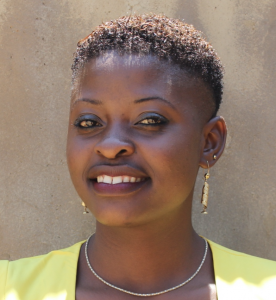April, 2020: Friends Kuvasali Secondary School Project Complete!
Please note, all photos in this report were taken before social distancing recommendations went into effect.
Friends Kuvasali Secondary School in Kenya now has access to a new source of safe, clean water thanks to the completion of their rain tank, which has the ability to collect 75,000 liters of water! We installed new latrines and handwashing stations for students, and we trained students and staff on improved sanitation and hygiene practices. All of these components work together to unlock the opportunity for these students to live better, healthier lives.

"This water point will positively and greatly impact my life here in school and even my future. This is because I will utilize all the time and opportunity I have to focus on my education. No more wastage of time queueing for water, no thirst shall render me helpless over lack of enough clean drinking water," said pupil Rasoa.
"Completion of this water point will help me achieve my education goal of having a mean grade that will take me directly to the university. During the training, we were taught that drinking enough clean water will help us have smooth and glowing skin, concentrate in class, and reduce communicable diseases. This is my goal which I would want to attain now that I have this water within my reach any time, any day."

Pupil Rasoa holds a big cup of clean water from the rain tank
Teachers were just as excited as the students about the new rain tank on campus.
"I shall be free from diseases like typhoid which has affected me for quite some time while in this school," said teacher Geoffrey Wamalika Chilali.
"I am now able to take water in school for in the past, if I did not manage to carry water from home then it meant I would go the whole day thirsty. With the profession of teaching, you talk until saliva is finished. Now I have peace of mind for my life will have a better turnaround with water near me. I am indeed grateful for this project and the whole organization for thinking of us and what I wish is for God to expand and enlarge the work for you to reach many other schools."

School Principal Joshua poses with the rain tank
Rain Tank
Construction for this 75,000-liter rain tank was successful!
Parents, staff, and students helped our artisans gather everything needed for construction. All the while, the school cooks and community members prepared meals for the artisans, and the school provided accommodations for the artisans during their work. Local women and men helped our artisans with their manual labor, too.

Community members help deliver water for construction
The process officially began with our staff and school administration looking around the school compound to try and determine the best location for a new rain tank. This needed to be the best site with enough land and a nearby building with good, clean roofing to catch the rainwater.

Laying the rain tank's stone foundation
Then, we cleared the site by excavating the soil to make level ground for the tank foundation. The foundation was cast by laying big stones on the level ground and reinforcing them using steel wire, concrete, and waterproof cement. Both the drawing pipe as well as the drainage pipe were affixed as the foundation was laid.

Sugar sacks tied to rain tank wire skeleton
Next, the walls were formed using a skeleton of rebar and wire mesh with sugar sacks temporarily tied to the outside as backing. This was attached to the foundation’s edges so that the work team could start the Ferro-cementing process, in which the walls are layered with cement alternating with the inner and outer side until 6 layers of cement are in place. (The sugar sacks are removed once the interior receives its first 2 layers of cement.)

Plastering inside the tank
Inside the tank, 1 central and 4 support pillars were cast to ensure the dome does not cave in once cemented. Meanwhile, the inner wall was plastered while the outer walls received their roughcasting. Outside of the tank, the access area to the tap was dug, plastered, and a short staircase installed, along with a soak pit where spilled water can drain from the access area through the ground. This helps to keep the tap area dry and tidy.

Support pillars get plastered inside the tank
Dome construction could begin after the tank walls had been given enough time to settle. Using similar techniques as used on the walls, the dome started as rebar, wire mesh, and sugar sacks and was attached to the tank walls before receiving cement and plaster. A small manhole cover was built into the dome to allow access for future cleanings and water treatments.

Attaching the dome skeleton with wooden support poles at the ready
Long wooden poles (about 75 of them!) were placed inside the tank to support the dome while it cured. A lockable manhole cover was fitted over the tap area, the gutters were affixed to the roof and the tank, and an overflow pipe was set in place at the edge of the dome for when the tank reaches capacity.

Once finished, the rain tank was given 3-4 weeks to undergo complete curing. Finally, the interior support poles and dome sugar sacks were removed, the tank was cleaned, and we waited as rain filled the tank with fresh water. When there was a sufficient volume in the tank, we treated the water and we officially handed it over to Friends Kuvasali Secondary School.

As soon as it was ready, students and staff celebrated the presence of clean water on campus. The event was a great chance for us to acknowledge the school administration and students as the primary parties entrusted with the tools we have given, as well as remind them of our continued support as they develop. Happiness, thanksgiving, and appreciation were the order of the day flowing in all directions.

VIP Latrines
This project funded the installation of 6 new ventilated improved pit (VIP) latrines, half for girls and half for boys.

Girls pose next to their new latrines
All of these new latrines have cement floors that are designed to be easy to use and clean. And with a rain tank right on school property, there should be enough water to keep them clean.

Boys pose in front of their new latrines
Handwashing Stations
The 2 handwashing stations were set up during training and handed over to the student health club. These were placed outside of the girls’ and boys’ latrines to encourage handwashing after latrine use. Health club members will teach other students how to properly wash their hands at the stations, make sure the stations are filled with water, and work to ensure that there is always a cleaning agent such as soap or ash available.

A student uses a handwashing station next to the rain tank
New Knowledge
Hygiene and sanitation training was scheduled with the help of the school principal, who ensured that the training date would be convenient for students, staff, and parent representatives. Individual teachers helped by selecting students from each class to represent the others. When the training day arrived, facilitators Jemmimah Khasoha and Laura Alulu deployed to the site.

Students do group work at training
34 students attended training, which was mostly conducted in one of the classrooms. It was the only place we could do the training for outside was too sunny, hot, and dry and could attract lots of distractions. In class, the students were alert and there was no congestion thus freeing the space for conducive learning. The group was active and lively, and students were ready to ask and answer questions all day. The school took it as a privilege to have the students receive the training and the students were definitely eager to rise to the occasion.

A pupil stands to share a response during training
We covered a number of topics including personal hygiene such as bathing, oral hygiene, and the 10 steps of handwashing; environmental hygiene; child rights; operation and maintenance of the rain tank, latrines, and handwashing stations; and leadership and governance. During the latter, the students elected their peers to lead their newly formed student health club.

Facilitator Laura Alulu in action at training
The club will be greatly involved in the water, sanitation, and hygiene project management at school and will be responsible for encouraging good health and hygiene practices amongst their peers, teachers, and the larger community. We involved stretches, dances, and physical activities in between each topic to keep the pupils’ energy up and their minds active. By the end of the training, each pupil understood their role in sustaining clean water and good health within their school community.

A student leads a handwashing demonstration
One of the most memorable topics was personal hygiene which made many participants wonder after one student who said he only takes a bath twice a week due to the chilly weather they get from the nearby hills. This was very scary and at the same time kept everyone wondering about the best advice on the same.
The trainer dug deeper into the topic, ensuring the participants understood that despite the weather, daily if not twice daily baths were suggested for optimum health and hygiene. The students were asked to take care of their body's better than any other thing. This was for the betterment of their wellbeing in and out of school, the facilitator explained.

A student explains proper care and maintenance of the tank in a practical session
Another memorable topic was life skills and decision making. One student during the session had a piece of advice to the others. She stated that she had not been punished once since joining the school, and that was a direct result of the decision she made on the day of admission - to always be on time and prepared. She learned that life skills can make you live longer and at peace which results in success.
A few of the things she quoted to her classmates were, "Having peace within yourself and a grateful heart leads to satisfaction," and "Respect for oneself and everyone else is paramount and a must-have value." The other students who were in the training and had known her earlier on in school agreed on her good character and commendable performance, and this became a great foundation for the new students who had just joined the school.

A student explains the parts and functions of the tank in a practical session
"This was one of the best trainings that opened the year well for me," said teacher Doreen Ambetsa.
"After the long holiday and spending time carelessly and eating any which way, attending this training reshaped my life. It did set the pace and helped me drive my life with a difference from the other years. All the topics taught touched me personally."

When an issue arises concerning the water project, the students and teachers are equipped with the necessary skills to rectify the problem and ensure the water point works appropriately. However, if the issue is beyond their capabilities, they can contact our team of field officers to assist them. In addition, we will continue to offer them unmatchable support as a part of our ongoing monitoring and maintenance program.
"This group has shown high levels of management skills," said the lead Field Officer for this project, Jemmimah Khasoha. "I consider the group reliable to maintain and manage the facilities without any difficulty."
Thank you for making all of this possible!


 Rainwater Catchment
Rainwater Catchment
 Rehabilitation Project
Rehabilitation Project















































